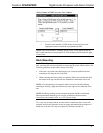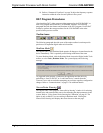
Digital Audio Processor with Room Control Crestron C2N-DAP8RC
22 • Digital Audio Processor with Room Control: C2N-DAP8RC Operations Guide - DOC. 8187A
Speaker Types
Different speaker types have different sound reproduction characteristics, which
affect their performance in a home theater environment. Crestron makes no specific
recommendations, and provides the following information for reference purposes
only.
To create the most realistic surround sound experience, it is recommended that you
match your speakers’ tonal characteristics. This is also known as ‘timbre matching.’
Direct Radiating
Direct radiating speakers provide a focused image, which makes it relatively easy to
detect the general location of the sound (localization). This opposes the type of open
sound you would expect in a large theater or concert hall.
Bipolar
Bipolar speakers have drivers on opposite sides of their cabinets, wired in phase, and
provide a diffuse sound. Sound radiates from both sides, so the sounds seem to be
coming from all around instead of from a specific location. Because the sound is
very open, it creates a larger ideal listening area, and speaker localization becomes
more difficult.
Dipolar
Dipolar speakers also have drivers on opposite sides of their cabinets and provide a
diffuse sound. These speakers operate 180°out of phase and create a sound field that
is more open than either the direct radiating or bipolar types. These speakers are
typically used in surround channel applications, and speaker localization becomes
the most difficult. This type of speaker is not recommended for front channels.
Subwoofers
Subwoofers are specially designed to reproduce the lowest ranges of audible
sound-usually from 120 Hz down to 20 Hz. These speakers are either powered or
non-powered. Non-powered subwoofers require an external amplifier and power
supply. Subwoofer output typically includes the information from the decoded LFE
channel and will include the low frequency information from the left, right, center
and surround channels when the speakers for those channels are unable to reproduce
the low frequency sounds, and bass management is enabled.
Speaker Arrangements
Refer to the diagram to the left of this paragraph and arrange the speakers in the
listening area according to these general guidelines. Refer to the instructions given in
“Surround Sound System Setup” on page 26 for optimum placement.
• Place front speakers so their front surfaces are as flush as possible with the
front of the viewing screen, and at an angle to the listening position of 45 to
60 degrees, with the primary drivers at ear level. Refer to manufacturer’s
instructions. Most recommend placement one to three feet from the wall.
• Depending upon the type of speakers used, surround speakers are usually
placed slightly behind and above ear level of the primary listening position,
approximately six feet above the finished floor.
• Place the surround back speakers at the rear of the listening area and at an
angle to the listening position of 60 to 90 degrees, with the primary drivers
LEFT
FRONT
RIGHT
FRONT
CENTER
LEFT
SURROUND
RIGHT
SURROUND
LEFT
BACK
SURROUND
RIGHT
BACK
SURROUND


















